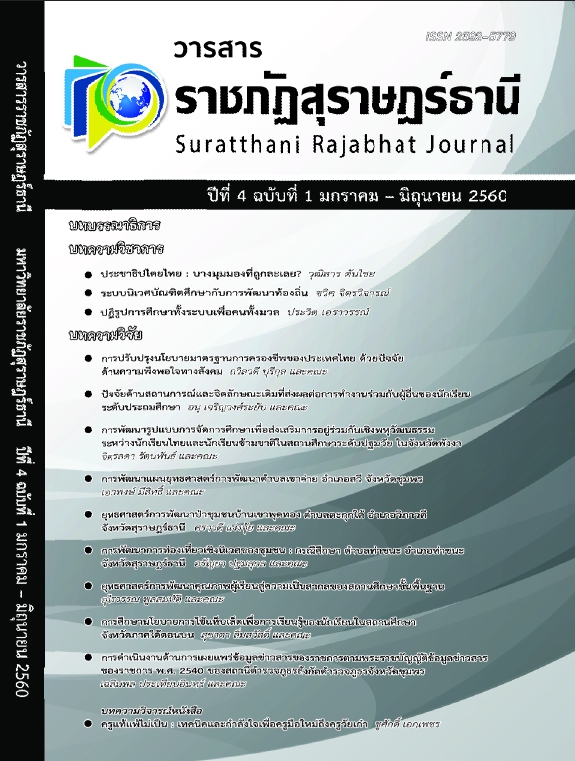การพัฒนารูปแบบการจัดการศึกษาเพื่อส่งเสริมการอยู่ร่วมกัน เชิงพหุวัฒนธรรม ระหว่างนักเรียนไทยและนักเรียนข้ามชาติ ในสถานศึกษาระดับปฐมวัย ในจังหวัดพังงา
Main Article Content
บทคัดย่อ
การวิจัยครั้งนี้มีวัตถุประสงค์เพื่อ 1) ศึกษาสถานการณ์และรูปแบบการจัดการศึกษาระหว่างนักเรียนไทยและนักเรียนข้ามชาติในสถานศึกษาระดับปฐมวัยที่อาศัยอยู่ในจังหวัดพังงา 2) เพื่อพัฒนารูปแบบการจัดการศึกษาที่ส่งเสริมการอยู่ร่วมกันเชิงพหุวัฒนธรรมระหว่างนักเรียนไทยและนักเรียนข้ามชาติในสถานศึกษาระดับปฐมวัย ในจังหวัดพังงา การวิจัยครั้งนี้เป็นการวิจัยและพัฒนา (Research and Development) ประกอบด้วยการวิจัย 2 ขั้นตอน คือ 1) ขั้นตอนการศึกษาสถานการณ์และรูปแบบการจัดการศึกษาระหว่างนักเรียนไทยและนักเรียนข้ามชาติที่อาศัยอยู่ในสถานศึกษาระดับปฐมวัยในจังหวัดพังงา มีพื้นที่ที่ศึกษา 4 โรงเรียน ใช้วิธีวิจัยเชิงคุณภาพ 2) ขั้นตอนการพัฒนาและการทดลองใช้รูปแบบการจัดการศึกษาเพื่อส่งเสริมการอยู่ร่วมกันเชิงพหุวัฒนธรรมระหว่างนักเรียนไทยและนักเรียนข้ามชาติในสถานศึกษาระดับปฐมวัย ใช้วิธีวิจัยเชิงปริมาณและคุณภาพ มีพื้นที่ที่ศึกษา 1 โรงเรียน คือ โรงเรียนกะปง
ผลการวิจัยในขั้นตอนศึกษาสถานการณ์และรูปแบบการจัดศึกษาสำหรับนักเรียนไทยและนักเรียนข้ามชาติที่ดำรงอยู่ในพื้นที่ที่ศึกษา พบว่า โรงเรียนทั้ง 4 แห่ง มีนโยบายรับนักเรียนข้ามชาติเข้าเรียนในโรงเรียน สำหรับการจัดชั้นเรียนนั้น 3 ใน 4 โรงเรียน จัดให้นักเรียนไทยเรียนร่วมชั้นกับนักเรียนข้ามชาติ โดยมีครูปฐมวัยชาวไทยเป็นผู้สอนและใช้ภาษาไทยในการสื่อสาร ส่วนอีก 1 โรงเรียนจัดชั้นเรียนแยกเป็นชั้นเรียนนักเรียนไทย มีครูปฐมวัยชาวไทยเป็นผู้สอนโดยใช้ภาษาไทยสื่อสาร และชั้นเรียนนักเรียนข้ามชาติ มีผู้สอนเป็นชาวพม่าและสื่อสารโดยใช้ภาษาพม่า ทุกโรงเรียนใช้หลักสูตรปฐมวัย พ.ศ. 2546 เป็นแนวทางในการจัดการศึกษา ยังไม่มีการพัฒนาศักยภาพบุคลากรในการจัดการศึกษาเชิงพหุวัฒนธรรม รูปแบบการศึกษาที่พบ เน้นให้นักเรียนข้ามชาติปรับตัวเข้ากับสังคมไทย และไม่ใช่การจัดการศึกษาในเชิงพหุวัฒนธรรม
ผลการวิจัยในขั้นตอนการพัฒนาและทดลองรูปแบบการจัดการศึกษาเพื่อส่งเสริมการอยู่ร่วมกันเชิงพหุวัฒนธรรมในสถานศึกษาระดับปฐมวัยพบว่า รูปแบบการจัดการศึกษาเพื่อส่งเสริมการอยู่ร่วมกันเชิงพหุวัฒนธรรมระหว่างนักเรียนไทยและนักเรียนข้ามชาติในสถานศึกษาระดับปฐมวัย มีองค์ประกอบ 7 ด้าน คือ ด้านนโยบายของสถานศึกษา ด้านหลักสูตร ด้านบุคลากร ด้านการจัดการเรียนรู้ ด้านบรรยากาศและสภาพแวดล้อม ด้านผู้ปกครองและด้านชุมชน เมื่อนำรูปแบบดังกล่าวไปทดลองใช้กับนักเรียนปฐมวัย ระดับอนุบาล 1 และ 2 ที่เข้าร่วมการทดลองจำนวน 10 คน ประกอบด้วย นักเรียนไทย 3 คน พม่า 1 คน และมอญ 6 คน ผลการวิจัยพบว่า ความรู้ของนักเรียนหลังการจัดการเรียนรู้มีค่าเฉลี่ยสูงกว่าก่อนการจัดการเรียนรู้อย่างมีนัยสำคัญทางสถิติที่ระดับ 0.05 และพบว่าค่าเฉลี่ยของพฤติกรรมการอยู่ร่วมกันเชิงพหุวัฒนธรรมของนักเรียนไทยและนักเรียนข้ามชาติ ภายหลังการทดลองมีค่าสูงกว่าค่าเฉลี่ยก่อนการทดลองอย่างมีนัยสำคัญทางสถิติที่ระดับ 0.05 นอกจากนี้ ผลการศึกษาในเชิงคุณภาพได้แสดงให้เห็นว่า นักเรียนไทยและนักเรียนข้ามชาติมีพฤติกรรมการอยู่ร่วมกันเชิงพหุวัฒนธรรมเพิ่มมากขึ้น ทั้งระหว่างและภายหลังการทดลอง พฤติกรรมดังกล่าว มีจำนวน 7 พฤติกรรม ได้แก่ การทักทายผู้อื่นนอกเหนือจากภาษาแม่ของตนเอง การนับเลขเป็นภาษาอื่นนอกเหนือจากภาษาแม่ การแนะนำผู้อื่นเกี่ยวกับวัฒนธรรมของตนเอง การสนใจเรียนวัฒนธรรมผู้อื่น การช่วยเหลือเพื่อนต่างวัฒนธรรม การเล่นกับเพื่อนต่างวัฒนธรรม และการมีปฏิสัมพันธ์กับผู้ปกครองของเพื่อนต่างวัฒนธรรม
สำหรับปัจจัยที่ทำให้นักเรียนเกิดการเปลี่ยนแปลงทั้งในเชิงความรู้และพฤติกรรมนั้นมาจากองค์ประกอบของรูปแบบการจัดการศึกษาแต่ละด้านที่มีส่วนสนับสนุนซึ่งกันและกัน เช่น ผู้บริหารมีนโยบายสนับสนุนการจัดการศึกษาเชิงพหุวัฒนธรรม มีหลักสูตรที่คำนึงถึงความแตกต่างและหลากหลายของผู้เรียน ครูปฐมวัยได้รับการพัฒนาศักยภาพให้มีความรู้และความเข้าใจเกี่ยวกับการจัดการศึกษาเชิงพหุวัฒนธรรมจนสามารถนำไปปฏิบัติได้ มีการจัดกระบวนการเรียนรู้ที่คำนึงถึงความหลากหลายของผู้เรียน มีการสร้างบรรยากาศและสภาพแวดล้อมในห้องเรียนปฐมวัยและโรงเรียนเพื่อให้เอื้อต่อการอยู่ร่วมกันเชิงพหุวัฒนธรรม มีการสร้างการมีส่วนร่วมอย่างเป็นรูปธรรมของผู้ปกครองและชุมชน ส่วนปัจจัยที่ทำให้องค์ประกอบในแต่ละด้านดังกล่าวข้างต้นสามารถเกิดผลได้ส่วนใหญ่เป็นผลโดยตรงจากการที่ผู้บริหารสถานศึกษาและครูปฐมวัย มีการปฏิบัติการอย่างเป็นรูปธรรมตามรูปแบบการจัดการศึกษาที่พัฒนาขึ้น ส่วนผู้วิจัยนั้นมีบทบาทในฐานะผู้กระตุ้นในบางองค์ประกอบเท่านั้น เช่น ด้านนโยบายสถานศึกษาและหลักสูตรเชิงพหุวัฒนธรรม
Article Details
เอกสารอ้างอิง
กระทรวงศึกษาธิการ. (2546). คู่มือหลักสูตรการศึกษาปฐมวัย พุทธศักราช 2546 (สำหรับเด็กอายุ 3 - 5 ปี). กรุงเทพฯ : สำนักงานคณะกรรมการการศึกษาขั้นพื้นฐานกระทรวงศึกษาธิการ.
_______. (2546). หลักสูตรการศึกษาปฐมวัย พุทธศักราช 2546. กรุงเทพฯ : สำนักงานคณะกรรมการการศึกษาขั้นพื้นฐานกระทรวงศึกษาธิการ.
กุลภา วจนสาระ. (2550). กรณีศึกษาจังหวัดพังงาและภูเก็ต รัฐไทยกับการปรับเปลี่ยนนโยบายเอดส์ และอนามัยเจริญพันธุ์ในกลุ่มแรงงานข้ามชาติ. นครปฐม : สถาบันวิจัยประชากรและสังคม มหาวิทยาลัยมหิดล.
ขวัญชีวัน บัวแดง. (2554). รายงานฉบับสมบูรณ์โครงการการปรับตัวทางสังคมและวัฒนธรรมของทายาทรุ่นที่ 2 ของผู้ย้ายถิ่นจากประเทศพม่า. กรุงเทพ : สำนักงานกองทุนสนับสนุนการวิจัย.
บุปผา อนันต์สุชาติกุล. (2554). รายงานการวิจัยฉบับสมบูรณ์เรื่องโครงการรูปแบบสำหรับทายาทรุ่นที่สองของผู้ย้ายถิ่นจากพม่า. กรุงเทพฯ : กองทุนสนับสนุนการวิจัย.
ประภาพรรณ อุ่นอบ. (2557). เอกสารประกอบการประชุมเชิงปฏิบัติการการถอดบทเรียน: เครื่องมือเพื่อการเรียนรู้ในการขับเคลื่อนโครงการพัฒนา. กรุงเทพฯ : คณะสังคมศาสตร์และมนุษยศาสตร์ มหาวิทยาลัยมหิดล.
พวงเพชร์ ธนสิน. (2554). รายงานฉบับสมบูรณ์โครงการ “ทายาทรุ่นที่ 2 ของผู้ย้ายถิ่นจากประเทศพม่า : สถานการณ์และการอพยพโยกย้าย”. เชียงใหม่ : คณะสังคมศาสตร์ มหาวิทยาลัยเชียงใหม่.
มอเก็น (ชาวเล). (มปป.). (Online), สืบค้นได้จาก : http://www.sac.or.th/ databases/ethnic/ content/ information/ref_moken.html
มาลี สันภูวรรณ. (2555). การศึกษาถ้วนหน้า : เด็กข้ามชาติในสวนยางพารามีโอกาสหรือไม่? ประชากรชายขอบและความเป็นธรรมในสังคมไทย. นครปฐม : สถาบันวิจัยประชากรและสังคม มหาวิทยาลัยมหิดล.
ยงยุทธ แฉล้มวงษ์. (2548). รายงานการวิจัยเรื่องการศึกษาเพื่อหารูปแบบที่เหมาะสมในการอยู่ร่วมกันกับแรงงานต่างด้าว กรณีศึกษาจังหวัดสมุทรสาคร. กรุงเทพฯ : สำนักเลขาธิการวุฒิสภา.
สำนักงานเขตพื้นที่การประถมศึกษาจังหวัดพังงา. (2553). ตารางรายชื่อนักเรียนที่ไม่ใช่สัญชาติไทยสังกัด สำนักงานคณะกรรมการการศึกษาขั้นพื้นฐาน. พังงา : สำนักงานเขตพื้นที่การประถมศึกษาจังหวัดพังงา.
สำนักงานเขตพื้นที่การประถมศึกษาจังหวัดพังงา. (2556). จำนวนนักเรียนจำแนกสัญชาติ. พังงา : สำนักงานเขตพื้นที่การประถมศึกษาจังหวัดพังงา.
________. (2556). นักเรียนจำแนกสัญชาติ รายชั้น รายโรง. พังงา : สำนักงานเขตพื้นที่การประถมศึกษาจังหวัดพังงา.
สำนักงานคณะกรรมการกลางอิสลามแห่งประเทศไทย. (มปป). คณะกรรมการอิสลามประจำจังหวัดพังงา. (Online), สืบค้นได้จาก : www.cicot.or.th. [2556, มิถุนายน 10].
สำนักงานเลขาธิการสภาการศึกษา. (2556). การดูแลแลการศึกษาเด็กปฐมวัย.กรุงเทพฯ : สำนักงานเลขาธิการสภาการศึกษา กระทรวงศึกษาธิการ.
องค์การยูนิเซฟ ประเทศไทย. (มปป). อนุสัญญาว่าด้วยสิทธิเด็ก. (Online), สืบค้นได้จาก : www.unicef.org/thailand/tha/overview_5954.html. [2556, มกราคม 14].
อัญชลี ไสยวรรณ. (2552). การศึกษาปฐมวัยในอนาคต. (Online), สืบค้นได้จาก : http://www.e-child-edu.com/youthcenter/content/articles/future-child-eduction.html. [2556, มกราคม 14].
Banks, J. A. (1981). Multiethnic Education Theory and Practice. Boston : Allyn and Bacon.
_______. (2001). Cultural Diversity and Education : Foundations curriculum and teacher. Boston : Allyn and Bacon.
Banks, J. A. (2003). Multicultural Education: Issues and Perspectives. New York : John Wiley & Son.
Joseph, O. & Diaz, P. (n.d.).The Factors that Affect the Educational Performance of Migrant Children. Education Journal, 111(4).
Platt, J. S. & Ann, C. G. (1991). Understanding and educating migrant students. Educational Intervention, 36(1).
Ricucci, R. (2008). Educating immigrant in a ‘newcomer’ immigration country a case study. International Education, 19(5) : October.
Romanovsky, M. (2003). Meeting the Unique Needs of the Children of Migrant Farm Works. Clearing House, 77(1) : October.
Somporn, S. (2010). Right to education for migrant children: challenge of policy implementation in Maesot district, Tak province. Thesis. Master of Arts, Faculty of Graduates Studies, Mahidol University.
Superuser. (2557). ภาษาถิ่นน่ารู้. (Online), สืบค้นได้จาก : www.phangnga.go.th.2014/index/php/th/about-us-4/tip/local. [2557, สิงหาคม 25].
Unicef Thailand. (2009). การพัฒนาเด็กปฐมวัย. (Online), สืบค้นได้จาก : http://www.unicef.org/ thailand/tha/education_6555.html. [2557, สิงหาคม 25].
_______. (2013). Early Childhood Development. (Online), สืบค้นได้จาก : http://wwwe.unicef.org/ thailand/tha/education_65555.html. [2557, สิงหาคม 25].
Whittaker, C. R. (1997). Voices from the fields’: Including migrant farmworkers in the curriculum. Reading Teacher, 50(6), 97 : March.


